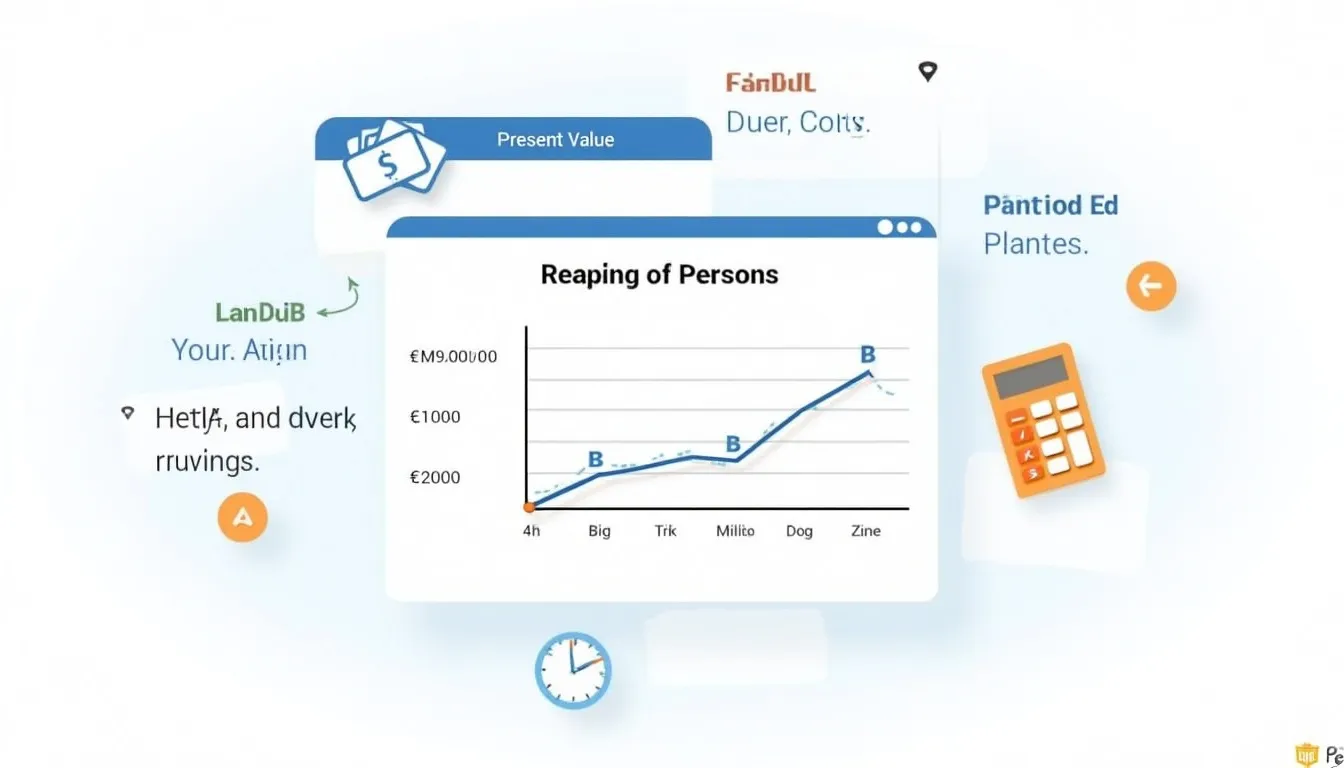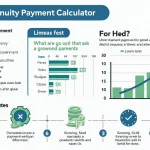Annuity Due Payment Calculator
Is this tool helpful?
Annuity Due Payment Calculator: Your Ultimate Tool for Financial Planning
How to Use the Annuity Due Payment Calculator Effectively
The Annuity Due Payment Calculator is a powerful financial tool designed to help you determine the periodic payment amount for an annuity due. To use this calculator effectively, follow these simple steps:
- Enter the Present Value: Input the current value of the annuity in the “Present Value” field. This represents the total amount you’re starting with or the lump sum you’re considering for an annuity.
- Input the Rate Per Period: In the “Rate Per Period (%)” field, enter the interest rate for each payment period as a percentage. For example, if the annual interest rate is 6% and payments are made monthly, you would enter 0.5 (6% ÷ 12 months).
- Specify the Number of Periods: Enter the total number of payment periods in the “Number of Periods” field. This could be the number of months, quarters, or years over which the annuity will be paid.
- Calculate: Click the “Calculate” button to generate your result.
- Review the Result: The calculator will display the Annuity Due Payment amount, which represents the periodic payment you’ll receive (or need to make) for the annuity.
By following these steps, you can quickly and accurately determine the payment amount for various annuity due scenarios, enabling you to make informed financial decisions.
Understanding Annuity Due Payments: A Comprehensive Introduction
An annuity due is a financial arrangement where a series of equal payments are made at the beginning of each period, rather than at the end. This type of annuity is common in various financial scenarios, including certain types of insurance premiums, rent payments, and some retirement plans.
The Annuity Due Payment Calculator is an essential tool for anyone dealing with this type of financial structure. It allows you to calculate the periodic payment amount based on the present value of the annuity, the interest rate, and the number of payment periods.
The calculator uses the following formula to determine the annuity due payment:
$$ \text{Payment} = \text{PV} \times \frac{r}{1 – (1 + r)^{-n}} \times \frac{1}{1 + r} $$
Where:
- PV = Present Value
- r = Rate per period
- n = Number of periods
This formula takes into account the time value of money, ensuring that the calculated payment accurately reflects the present value of the annuity, the interest rate, and the payment schedule.
Benefits of Using the Annuity Due Payment Calculator
Incorporating the Annuity Due Payment Calculator into your financial planning toolkit offers numerous advantages:
- Precision and Accuracy: The calculator eliminates human error in complex financial calculations, providing you with precise results every time.
- Time-Saving: Instead of manually working through the annuity due formula, you can get instant results with just a few clicks.
- Scenario Planning: Easily compare different annuity scenarios by quickly adjusting variables like interest rates or payment periods.
- Informed Decision-Making: By providing clear, accurate payment amounts, the calculator empowers you to make well-informed financial decisions.
- Financial Education: Using the calculator helps you understand the relationship between present value, interest rates, and payment amounts in annuities.
- Budgeting Tool: For those paying into an annuity, the calculator helps in budgeting by providing exact payment amounts.
- Retirement Planning: It’s an invaluable tool for planning retirement income from annuities, helping you visualize your future financial situation.
Addressing User Needs and Solving Specific Problems
The Annuity Due Payment Calculator addresses several key user needs and solves specific problems in financial planning:
1. Simplifying Complex Calculations
Calculating annuity due payments manually can be complex and time-consuming. This calculator simplifies the process, making it accessible to both financial professionals and individuals without specialized mathematical knowledge.
2. Enhancing Financial Planning Accuracy
By providing precise payment amounts, the calculator helps users create more accurate financial plans. This is crucial for both short-term budgeting and long-term financial strategies.
3. Facilitating Better Investment Decisions
When considering different annuity options, the calculator allows users to quickly compare various scenarios. This enables more informed investment decisions based on concrete numbers rather than estimates.
4. Improving Retirement Planning
For those planning retirement, understanding potential annuity payments is crucial. The calculator helps users determine if their planned annuities will provide sufficient income during retirement.
5. Assisting in Loan and Lease Calculations
In scenarios where payments are made at the beginning of periods (like some leases or loans), this calculator provides accurate payment amounts, helping in negotiation and planning.
6. Supporting Financial Education
The calculator serves as an educational tool, helping users understand the relationship between present value, interest rates, and payment amounts in annuities. This knowledge is valuable for overall financial literacy.
Practical Applications and Use Cases
The Annuity Due Payment Calculator has a wide range of practical applications across various financial scenarios. Here are some real-world examples:
1. Retirement Planning
Scenario: John is 55 and planning to retire at 65. He wants to know how much he’ll receive monthly from a $500,000 annuity with a 4% annual interest rate over 20 years.
Application: Using the calculator, John enters:
- Present Value: $500,000
- Rate Per Period: 0.33% (4% ÷ 12 for monthly payments)
- Number of Periods: 240 (20 years × 12 months)
The calculator shows John his monthly payment, helping him determine if this annuity meets his retirement income needs.
2. Insurance Premium Calculations
Scenario: An insurance company needs to determine the monthly premium for a policy with a present value of $100,000, an annual interest rate of 3%, over a 10-year term.
Application: The company uses the calculator with:
- Present Value: $100,000
- Rate Per Period: 0.25% (3% ÷ 12)
- Number of Periods: 120 (10 years × 12 months)
The result helps the company set an appropriate monthly premium for the policy.
3. Lease Payment Structuring
Scenario: A business is leasing equipment worth $50,000 for 5 years, with payments due at the beginning of each month and an annual interest rate of 6%.
Application: The business uses the calculator with:
- Present Value: $50,000
- Rate Per Period: 0.5% (6% ÷ 12)
- Number of Periods: 60 (5 years × 12 months)
The calculated monthly payment helps the business budget for the lease expenses.
4. Savings Goal Planning
Scenario: Sarah wants to save $20,000 for a down payment on a house in 3 years. She wants to know how much she needs to deposit monthly into a savings account paying 2% annual interest.
Application: Sarah uses the calculator in reverse, entering:
- Present Value: $20,000
- Rate Per Period: 0.167% (2% ÷ 12)
- Number of Periods: 36 (3 years × 12 months)
The result shows Sarah how much she needs to save each month to reach her goal.
5. Loan Repayment Analysis
Scenario: A bank is structuring a $200,000 business loan with payments due at the beginning of each quarter, a 5% annual interest rate, and a 7-year term.
Application: The bank uses the calculator with:
- Present Value: $200,000
- Rate Per Period: 1.25% (5% ÷ 4)
- Number of Periods: 28 (7 years × 4 quarters)
The calculated quarterly payment helps the bank structure the loan repayment schedule.
Frequently Asked Questions (FAQ)
1. What is an annuity due?
An annuity due is a series of equal payments made at the beginning of each period, as opposed to an ordinary annuity where payments are made at the end of each period. Common examples include rent payments (paid at the start of the month) and some insurance premiums.
2. How is an annuity due different from a regular annuity?
The main difference is the timing of payments. In an annuity due, payments are made at the beginning of each period, while in a regular (ordinary) annuity, payments are made at the end of each period. This timing difference affects the present value and future value calculations.
3. Why do I need to use a specific calculator for annuity due payments?
An annuity due calculator accounts for the unique timing of payments in this type of annuity. Using a regular annuity calculator would result in incorrect calculations, as it assumes payments are made at the end of each period.
4. Can this calculator be used for both receiving and paying annuities?
Yes, the Annuity Due Payment Calculator can be used for both scenarios. If you’re receiving payments, the result shows how much you’ll receive each period. If you’re making payments, it shows how much you need to pay each period.
5. Can I use this calculator for different payment frequencies?
Yes, you can use this calculator for various payment frequencies (monthly, quarterly, annually, etc.) by adjusting the rate per period and number of periods accordingly. For example, for monthly payments on an annual rate, divide the annual rate by 12 and multiply the number of years by 12.
6. What if I want to calculate the present value instead of the payment amount?
This calculator is specifically designed to calculate the payment amount given the present value. For calculating the present value, you would need a different calculator or to solve the annuity due formula algebraically for the present value.
7. How does inflation affect annuity due payments?
This calculator doesn’t directly account for inflation. To consider inflation, you might adjust the interest rate input to reflect a “real” interest rate (nominal rate minus inflation rate) or use the results in conjunction with separate inflation calculations.
8. Can this calculator be used for perpetuities?
No, this calculator is designed for annuities with a finite number of periods. A perpetuity, which is an annuity that continues indefinitely, requires a different calculation method.
9. Is the Annuity Due Payment Calculator suitable for all types of financial planning?
While the calculator is versatile and useful for many financial planning scenarios involving annuities due, it’s important to remember that it’s one tool among many. For comprehensive financial planning, especially for complex situations, it’s advisable to consult with a financial professional.
Conclusion: Empowering Your Financial Decision-Making
The Annuity Due Payment Calculator is an indispensable tool for anyone dealing with annuities, financial planning, or specific payment structures where transactions occur at the beginning of periods. By providing quick, accurate calculations, it empowers users to make informed financial decisions, plan effectively for the future, and understand complex financial concepts with ease.
Key benefits of using this calculator include:
- Precision in financial calculations
- Time-saving efficiency
- Enhanced ability to compare different financial scenarios
- Improved accuracy in budgeting and retirement planning
- Better understanding of the relationship between present value, interest rates, and payment amounts
Whether you’re a financial professional, a business owner, or an individual planning for your financial future, the Annuity Due Payment Calculator offers valuable insights that can significantly impact your financial strategies and outcomes.
We encourage you to make full use of this powerful tool in your financial planning processes. Remember, while the calculator provides accurate mathematical results, it’s always wise to consider these calculations in the broader context of your overall financial situation and goals. For complex financial decisions, consider consulting with a qualified financial advisor who can provide personalized advice tailored to your specific circumstances.
Take control of your financial future today – start using the Annuity Due Payment Calculator and unlock the power of precise, informed financial planning!
Important Disclaimer
The calculations, results, and content provided by our tools are not guaranteed to be accurate, complete, or reliable. Users are responsible for verifying and interpreting the results. Our content and tools may contain errors, biases, or inconsistencies. We reserve the right to save inputs and outputs from our tools for the purposes of error debugging, bias identification, and performance improvement. External companies providing AI models used in our tools may also save and process data in accordance with their own policies. By using our tools, you consent to this data collection and processing. We reserve the right to limit the usage of our tools based on current usability factors. By using our tools, you acknowledge that you have read, understood, and agreed to this disclaimer. You accept the inherent risks and limitations associated with the use of our tools and services.







